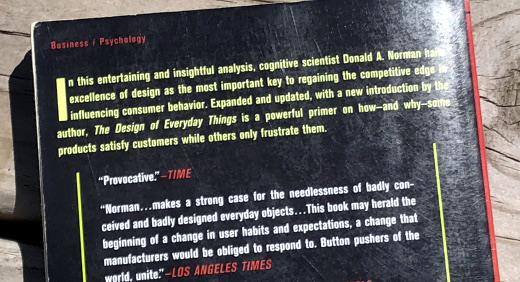Bookmarked. I just started reading a lot about design and design thinking.
My Takeaways From Rereading The Design Of Everyday Things
Shouldn’t things just work?
While on vacation last summer, we rented a car and got upgraded to a large SUV, a model I never drove before. When I got in I took a quick look around, pushed the start button and drove off. It got dark and foggy as we drove to the distant destination and the windshield started fogging up. So I looked and felt around the steering column and dashboard for the wipers and defogger, unfortunately without any luck. Having no other option, I pulled to the side of the road that really had no shoulder – much to the dismay of traffic behind me – and found a lever directly behind another lever on the steering column, and after a few twists activated the wipers and defogger and was able to see the rest of the way.
Has something like this happened to you? Have you tried to use something you think should just work, or find something on an item where you’d least expect it? This time it was a car, other times it’s a lamp, or even computer software. This thinking and frustration is the premise of the book The Design of Everyday Things by Donald Norman, an expert on usability.
Going thru some books I already read and still held onto, I decided to reread this classic book, and it brought back memories of the first time I read it; good memories from the material I learned in the book and bad ones because there’s still a lot of design issues out there that cause for poor user experiences. Those memories are structured into the following takeaways.
It’s not just us – When we have a poor user experience or trouble doing something, we tend to beat on ourselves. I have seen this a lot with computers, as some people are expecting a computer to just “do” something, and they often need more information, like a manual or someone to show them how, in order to complete a task. This happens to myself with software, Web sites or apps as well; I, someone who builds these, am expecting something or a certain outcome, and am not finding it that way. I chalk these up to bad design, where the one who created it never took into consideration how people would use it, or got feedback from observing people using it.
Internal vs. External Knowledge – This concept refers to internal knowledge as “in the head” as compared to external as “in the world” knowledge. Examples include knowing how to do something vs. having a manual or instructions on how to do it, to remembering a birthday to getting a calendar alert to remind you it is someone’s birthday. We bring internal knowledge into every situation, but sometimes need external knowledge to reinforce or remind or simply tell us how to do whatever it is.
There is good design out there – Where the book highlights a lot of bad design, it does talk about good design. I often reflect on an experience – e.g. driving a different car or going to a new place – and think of the user experience. I will smile if it was a good experience and complain if it wasn’t.
Bad design is an ongoing concern –The edition of The Design of Everyday Things I read was republished in 2002, and its original version came out in 1988 (note a later version was revised and expanded in 2013). Now 17 years after the republish, where a reader may get a chuckle when seeing some of the “dated” examples of items with poor design (for example, the telephone pictured), the principles written by Norman years ago are still very relevant today.
The Design of Everyday Things is not solely about computers or technology. I say this as perhaps my examples or even my background may imply this, plus the fact Donald Norman is a co-founder of Nielsen Norman Group - a firm that works in design and user experience, a lot of it centered on technology but not exclusively. I recommend this to any psychologist or student of the mind to anyone who gets easily frustrated when things don’t just work for them, or both. As I pass along all books, I am finally offloading this one, giving it to someone whom I met at a networking event a while back and to whom I offered the book… whether she has the internal knowledge of this, or needs this post as external knowledge, I will soon find out.
This is from The Hot Iron, a journal on business and technology by Mike Maddaloni.
Did you enjoy this? Subscribe to The Hot Iron by RSS/XML feed or Read by Email
Book Take-Aways •
Web Design •
(1) Comments •
Permalink
Comments
Post a Comment
Note: Comment moderation is active, and your comment will be viewable once it is reviewed.


